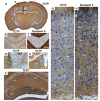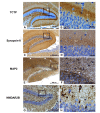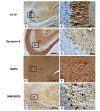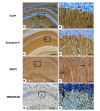Immunohistochemical Localization of Translationally Controlled Tumor Protein in Axon Terminals of Mouse Hippocampal Neurons
- PMID: 28442944
- PMCID: PMC5403910
- DOI: 10.5607/en.2017.26.2.82
Immunohistochemical Localization of Translationally Controlled Tumor Protein in Axon Terminals of Mouse Hippocampal Neurons
Abstract
Translationally controlled tumor protein (TCTP) is a cytosolic protein with microtubule stabilization and calcium-binding activities. TCTP is expressed in most organs including the nervous system. However, detailed distribution and functional significance of TCTP in the brain remain unexplored. In this study, we investigated the global and subcellular distributions of TCTP in the mouse brain. Immunohistochemical analyses with anti-TCTP revealed that TCTP was widely distributed in almost all regions of the brain including the cerebral cortex, thalamus, hypothalamus, hippocampus, and amygdala, wherein it was localized in axon tracts and axon terminals. In the hippocampus, TCTP was prominently localized to axon terminals of the perforant path in the dentate gyrus, the mossy fibers in the cornu ammonis (CA)3 region, and the Schaffer collaterals in the CA1 field, but not in cell bodies of granule cells and pyramidal neurons, and in their dendritic processes. Widespread distribution of TCTP in axon tracts and axon terminals throughout the brain suggests that TCTP is likely involved in neurotransmitter release and/or maintaining synaptic structures in the brain, and that it might have a role in maintaining synaptic functions and synaptic configurations important for normal cognitive, stress and emotional functions.
Keywords: Cognition; Immunohistochemistry; Mossy fiber; Mouse hippocampus; Translationally Controlled Tumor Protein (TCTP).
Figures




Similar articles
-
Distribution, morphological features, and synaptic connections of parvalbumin- and calbindin D28k-immunoreactive neurons in the human hippocampal formation.J Comp Neurol. 1993 Nov 8;337(2):208-30. doi: 10.1002/cne.903370204. J Comp Neurol. 1993. PMID: 8276998
-
A light and electron microscopic analysis of the mossy fibers of the rat dentate gyrus.J Comp Neurol. 1986 Apr 22;246(4):435-58. doi: 10.1002/cne.902460403. J Comp Neurol. 1986. PMID: 3700723
-
Distribution of calbindin D28k immunoreactive cells and fibers in the monkey hippocampus, subicular complex and entorhinal cortex. A light and electron microscopic study.J Hirnforsch. 1994;35(4):473-86. J Hirnforsch. 1994. PMID: 7884210
-
Ultrastructural description of glutamate-, aspartate-, taurine-, and glycine-like immunoreactive terminals from five rat brain regions.J Electron Microsc Tech. 1990 May;15(1):49-66. doi: 10.1002/jemt.1060150106. J Electron Microsc Tech. 1990. PMID: 1971014 Review.
-
Synapses formed by normal and abnormal hippocampal mossy fibers.Cell Tissue Res. 2006 Nov;326(2):361-7. doi: 10.1007/s00441-006-0269-2. Epub 2006 Jul 4. Cell Tissue Res. 2006. PMID: 16819624 Review.
Cited by
-
Downregulation of transcription factor TCTP elevates microRNA-200a expression to restrain Myt1L expression, thereby improving neurobehavior and oxidative stress injury in cerebral palsy rats.Cell Cycle. 2020 Apr;19(8):855-869. doi: 10.1080/15384101.2020.1717044. Epub 2020 Mar 15. Cell Cycle. 2020. Update in: Cell Cycle. 2023 Jan;22(1):150. doi: 10.1080/15384101.2022.2151242. PMID: 32174219 Free PMC article. Updated.
-
Dysregulation of TCTP in Biological Processes and Diseases.Cells. 2020 Jul 7;9(7):1632. doi: 10.3390/cells9071632. Cells. 2020. PMID: 32645936 Free PMC article. Review.
References
-
- Bommer UA. Cellular function and regulation of the translationally controlled tumour protein TCTP. Open Allergy J. 2012;5:19–32.
-
- Wang D, Gao L. Proteomic analysis of neural differentiation of mouse embryonic stem cells. Proteomics. 2005;5:4414–4426. - PubMed
-
- Corti V, Sanchez-Ruiz Y, Piccoli G, Bergamaschi A, Cannistraci CV, Pattini L, Cerutti S, Bachi A, Alessio M, Malgaroli A. Protein fingerprints of cultured CA3-CA1 hippocampal neurons: comparative analysis of the distribution of synaptosomal and cytosolic proteins. BMC Neurosci. 2008;9:36. - PMC - PubMed
-
- Li F, Zhang D, Fujise K. Characterization of fortilin, a novel antiapoptotic protein. J Biol Chem. 2001;276:47542–47549. - PubMed
-
- Kim SH, Cairns N, Fountoulakisc M, Lubec G. Decreased brain histamine-releasing factor protein in patients with Down syndrome and Alzheimer's disease. Neurosci Lett. 2001;300:41–44. - PubMed
LinkOut - more resources
Full Text Sources
Other Literature Sources
Miscellaneous

